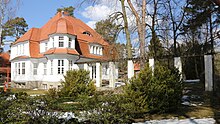Emil Kopp (architect)
Emil Kopp (* 1848 in Potsdam ; † 1928 in Bad Saarow ) was a German architect .
life and work
After studying architecture and completing his military service, Emil Kopp began to work in the civil service and then independently in private construction. Emil Kopp worked particularly in Bad Saarow . He planned and built villas in the Bad Saarow-Pieskow country house colony , was the architect of the important objects in the city and shaped the architectural style of the place.
In 1908/1909 he and Ludwig Lesser built today's Hotel Raueneck with a chauffeur's house at Ahornallee 5.
In 1910, in cooperation with Siegfried Bernstein, the Bad Saarow train station followed , opened in 1911 and is now a listed building.
In addition, Kopp designed the mud bath, the “Seeblick” hotel and the town hall. He also designed some villas for the new residents of Saarow, who moved here from Berlin in 1910 or who set up their summer residence here, such as the houses at Ahornstrasse 6 and 8 and Seestrasse 29 (Landhaus Wagner). In 1910/11 the mourning hall at the Jewish cemetery in Potsdam was built according to plans by Carl Börnstein (* 1868) and Emil Kopp .
1919–1920 he designed the country house for Ernst Wagner at Seestrasse 29 in Bad Saarow.
Kopp had been married since 1887 and had two sons. He worked with his son Ernst Kopp , who also became an architect. Some projects cannot be exactly assigned, as both signed their work with E. Kopp .
literature
- Reinhard Kiesewetter: dream housing Bad Saarow. Bad Saarow 2002.
Web links
Individual evidence
- ↑ Peter R. Pawlik: From Saarow to Alexandria - Ernst Kopp (1890–1962): The detours of an important hospital builder. Herzogenrath 2013, ISBN 978-3935791458
- ↑ ABOUT OUR HOUSE. In: Hotel Raueneck. Retrieved August 5, 2020 .
- ^ German Jewish architects before and after 1933: das Lexikon, p. 67 ( online )
- ↑ 20x Brandenburg, p. 116 ( online )
- ^ Paul Sigel, Silke Dähmlow, Frank Seehausen, Lucas Elmenhorst: Architekturführer Potsdam , Berlin 2006, ISBN 3-496-01325-7 , p. 74.
- ↑ 09115426. In: Monuments in Brandenburg. Retrieved August 2, 2020 .
| personal data | |
|---|---|
| SURNAME | Kopp, Emil |
| BRIEF DESCRIPTION | German architect |
| DATE OF BIRTH | 1848 |
| PLACE OF BIRTH | Potsdam |
| DATE OF DEATH | 1928 |
| Place of death | Bad Saarow |



